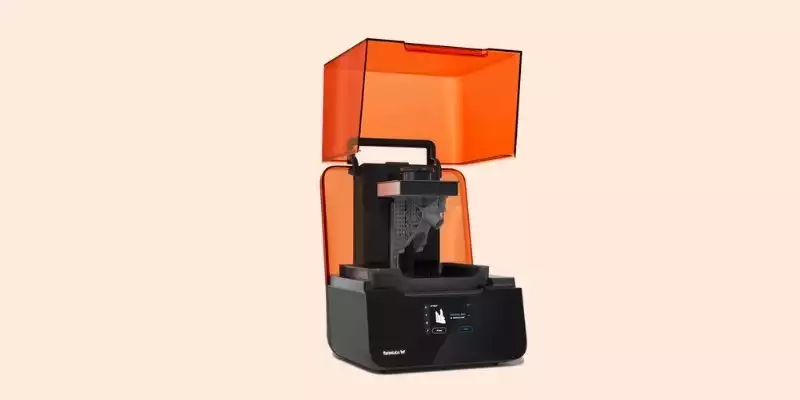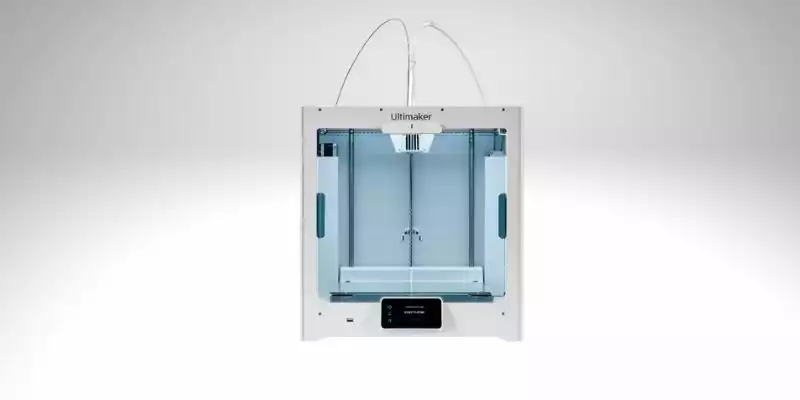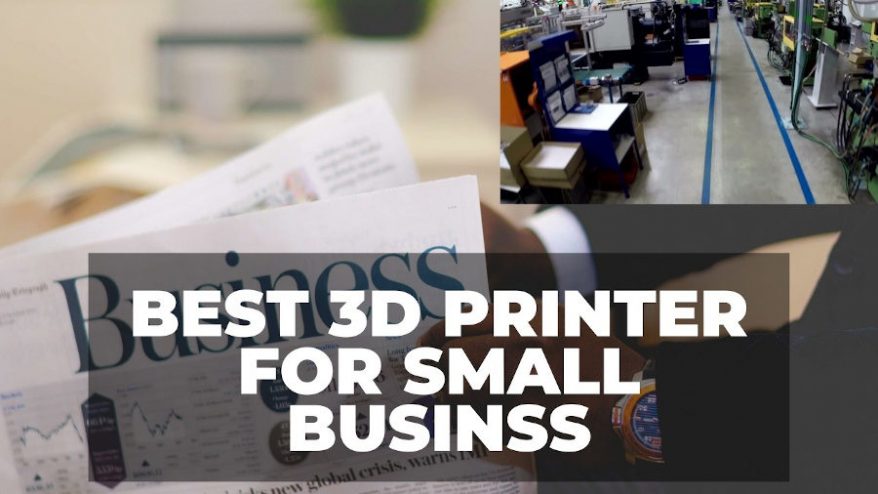
Whether you’re looking to dive into professional 3D printing for the first time or level up an existing print farm, we’re here to nudge you in the right direction with our guide to the best 3D printers for small businesses.
Nowadays, a business-ready printer needs to do more than generate affordable high-quality parts and prototypes; it must actively improve productivity and streamline workflows. Below, you’ll find a curated selection of the most reliable and user-friendly mid-range printers on the market today that provide value to fledgling and established businesses alike.
|
|
|
|
$3750
|
$6950
|
|
|
Our picks are tried-and-tested workhorses fit for applications from fast-prototyping to end-use part fabrication and everything in between. Let’s dive in.
Best 3D Printers for Small Business
3DSourced is reader-supported. When you buy through links on our site, we may earn an affiliate commission. Learn more
Formlabs Form 3+ / 3L – professional resin printer
- Form 3+ price: $3,499 — Available at Dynamism here
- Form 3L price: $10,999 — Available at Dynamism here
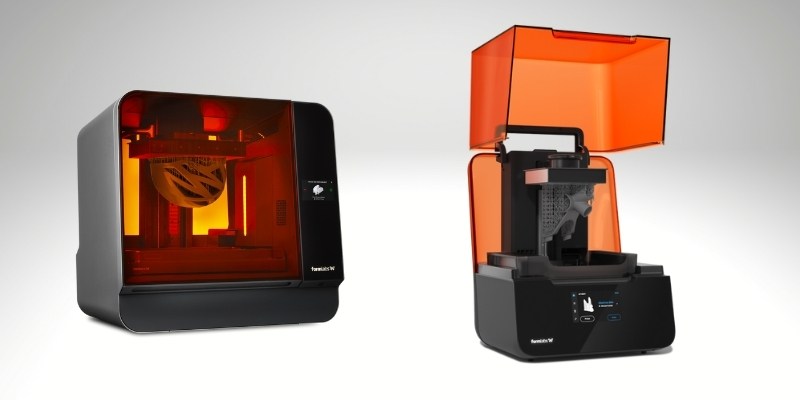
Pros
Gold standard in small business resin 3D printing for commercial use.
Extremely fine details and precision: ideal for jewelry, prototyping, dentistry, and more.
Cons
Standard Form 3 has small print area, so less suited for larger models. You can upgrade from the standard Form 3 to the Form 3+ for larger build volume.
The resin Formlabs 3+ and Formlabs 3L printers are designed from the ground up for the fast-paced, productivity-focused activities of small businesses that aim to circumvent outsourcing. They allow companies to easily bring streamlined, affordable prototyping and functional, end-use part fabrication in-house.
Print quality is nothing short of industry-quality with fast, precision printing that stands out for the richness of its features and flawless surface finish. These printers excel in fields that require highly accurate and functional parts such as jewelry making, hybrid visual effects production, engineering, medicine, and miniature/figurine making.
Read more: the best resin 3D printers
The two printers are fundamentally the same machines, except the FormLab 3L offers a larger 335 × 200 × 300 cm build volume and two light processing units to make up for the larger build platform. If your activities involve larger models or prototypes, or you need to batch print bigger quantities of smaller parts, we recommend the FormLab 3L. Otherwise, the FormLab 3+ offers the same reliable precision and speed at a more palatable price.
The Formlabs Form 3+ and 3L’s productivity focus extends to the surrounding ecosystem for a seamless end-to-end workflow. You can switch between 30 different resin types, each with its characteristics and properties, in a matter of seconds via Formlab’s easy swappable cartridges. Formlabs Form Wash and Form Cure accessories completely automate the post-processing of resin print with set-and-forget functionality.
Formlabs PreForm SLA software is stacked with automated features such as adaptive layer thickness, mesh repair, and support generation for genuine one-click printing. Cloud-based dashboard monitoring and print management also mean you can scale up with multiple printers or queue up several prints from anywhere with little hassle.
Investing into the complete Formlabs ecosystem doesn’t come cheap, which may be prohibitive to some businesses. In that case, the Prusa SL1S Speed is an excellent lower-priced alternative. As it carries the Prusa name, you’re buying into 3D printing royalty here. It’s fast, easy to use, delivers professional-level print quality, and keeps running costs low.
Ultimaker S5 / S5 Pro Bundle
- Ultimaker S5 price: $6,355 — Available at Dynamism here / Matterhackers here
- Ultimaker S5 Pro Bundle Upgrade: $3,685 — Available at Dynamism here / Matterhackers here
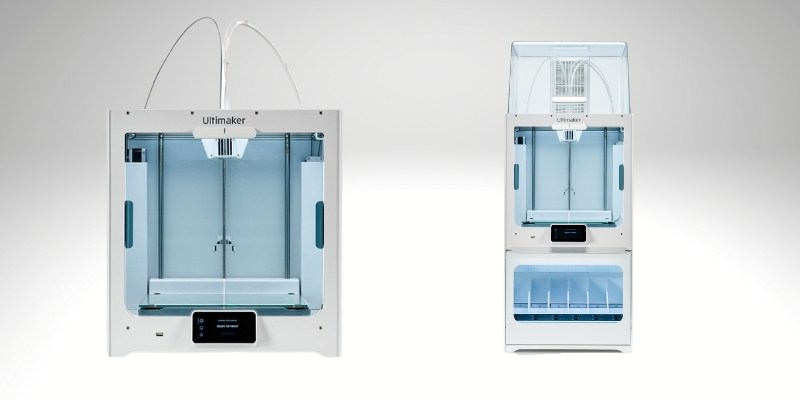
Pros
Excellent, best-in-class precision and accuracy for high-quality prototyping.
Fits well into a commercial workflow: Ultimaker offer software products for industrial needs and 3D printer factories.
Cons
Once you add on the Pro Bundle, you start veering towards a 5-figure investment. There are cheaper printers that offer similar specs, such as those by Raise3D.
The Ultimaker S5 and S5 Pro are workhorse FDM productivity printers for high-precision rapid prototyping of functional parts destined for the arts, medicine, engineering, automotive, consumer good production lines, and architecture, to name a few.
Much like Ultimaker’s consumer-grade printers, both the S5 and S5 Pro have ease-of-use baked in, emphasizing hassle-free throughput improvement while keeping down costs. At the center of this is a dual extrusion system, compatibility with a broad range of filaments, effortless network printer control, and near-zero onboarding one-click printing through Ultimaker’s Digital Factory software.
Thanks to desirable and identical specification sheets, the Ultimaker S5 and S5 Pro produce industry-grade prints, notably for a level of detail and smoothness run-of-the-mill FDM printers rarely achieve. The Ultimaker S5 and S5 Pro deliver durable, accurate parts such as pre-fabrication mockups, prototypes, functional parts, tools, and proof-of-work concepts.
The Ultimaker S5 Pro is an S5 with an enclosed, temperature-controlled material station tacked on. The station filters out toxic fumes while maintaining a dust and humidity-free environment through a robust air filtration system to keep materials in an optimum state.
Additionally, the station can house up to six different front-loaded filament spools simultaneously. Automatic material handling manages spool changeovers and run-out switching to ensure printing continues uninterrupted. It’s genuinely hands-off printing.
While smaller than its S5 sibling in footprint and build volume, the Ultimaker S3’s more affordable price tag, tighter footprint, and identical specifications make it a solid choice for smaller businesses with less cash to spare.
Raise3D Pro2 / Pro2 Plus
- Pro2 price: $3,999 — Available at Dynamism here / Matterhackers here
- Pro2 Plus price: $5,999 — Available at Dynamism here / Matterhackers here

Pros
Choice of standard or extra-large Pro2 Plus version (and new Pro3).
Excellent built-in analytics for in-depth real-time print analytics requiring less management.
Ideal prototyping 3D printer for industrial and small business use.
Cons
Newer Raise3D Pro3 version is now available (but more expensive).
Touted by Raise 3D as the ‘best industrial-grade 3D printer’ under the sun, the Raise3D Pro2 and its pricier counterpart, the Pro2 Plus, offer fast, high-detail printing backed by a durable and production-line-sturdy frame. They would both be reliable additions to a productivity-focused small business looking for a robust and versatile manufacturing and rapid-prototyping solution.
Standout features include dual extruders, a comprehensive HEPA air filtration system, and management of the entire printing process from end-to-end through the RaiseCloud software, allowing you to juggle a flock of printers remotely with ease.
The Raise3D Pro2 and Pro2 Plus material compatibility is extensive, with support for PLA, ABS, HIPS, PC, TPU, TPE, PETG, ASA, PP, PVA, Nylon, and Glass Fiber Infused, Carbon Fiber Infused, Metal Fill, Wood and Fill.
With the same underlying hardware and specifications as the Raise3D Pro2, the Raise3D Pro2 Plus splits in build volume. It ups the single extrusion build volume to 305 x 305 x 605 mm and dual extrusion volume to 280 x 305 x 605 mm, adding verticality for taller prints.
It’s also worth mentioning the Raise3D E2 in passing. A smaller footprint and build volume allied to an IDEX system see the Raise3D E2 take on the form of a desktop printer. A strong pick for small design studios that don’t need as much print area as that offered by the industrial-geared Pro2 machines.
Prusa i3 MK3S+ – Best Low-Cost 3D Printer for Small Business
- Price: $999 — Available at Prusa store here
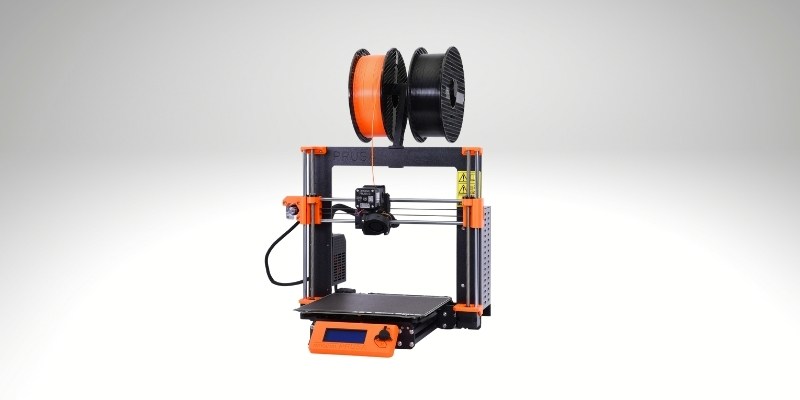
Pros
The most reliable and durable 3D printer under $1000.
If you’re only looking to product smaller parts in your small business, this should be more than enough.
Upgradable with MMU kit to print 5 colors of filament at once – handy for multi-color business prototypes.
Cons
Doesn’t come with an enclosure, so if you want to print tougher filaments you’ll need to purchase this.
Far less analytics and general small business workflow tools than other more commercial-focused printers.
A darling among amateur makers across the globe, the Prusa i3 MK3S+ slides into our list as a low-cost savior for the smallest businesses put off by the exorbitant price tags of the Form 3+ and Ultimaker S5.
Even though the Prusa i3 MK3S+ is a workhorse in its own right, this isn’t a manufacturing tool or design powerhouse like the other best 3D printers for small businesses we’ve handpicked. The footprint is considerably smaller than most professional-grade printers for business use. If you operate out of your home, the Prusa i3 MK3S+ won’t take over an entire room.
Smaller and less ambitious, we see it as a dependable accessory for companies wanting to quickly pump out the odd high-quality prototype or focus on small, high-detail, limited-run parts.
The Prusa i3 MK3S+ does just that, but without sacrificing the quality of the finished product. The print results flirt with those you’d expect from the other printers on our list, but at a fraction of the cost. A trove of integrated fail-safe tools and sensors guarantees easy printing with all-around quality hardware to match and decent material compatibility, including PLA, PETG, ASA, PC, HIPS, and more.
Straightforward printing and software are equally appealing for fledgling businesses dabbling in 3D printing for the first time. You won’t be bogged down having to juggle a fleet of printers via a cloud-based management system.
Desktop Metal Studio System – Best Metal 3D Printer for Small Business
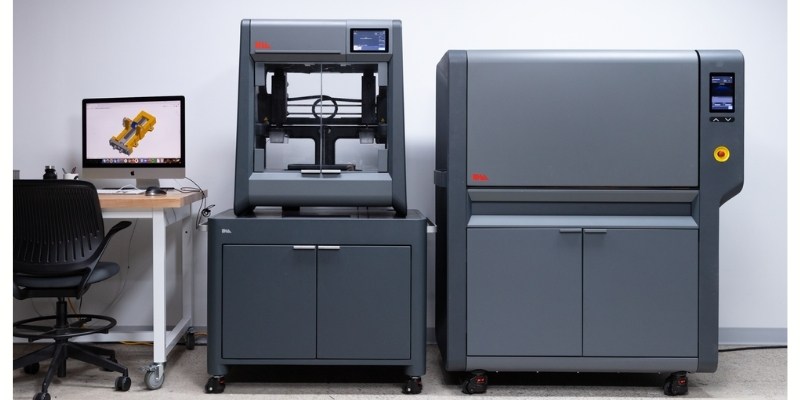
Matter-of-fact naming aside, the Desktop Metal Studio System swoops in as a solid, bleeding-edge metal printing solution suitable for prototyping, manufacturing, automotive design, consumer goods, and even small, one-off parts destined for heavy industry applications.
As the name implies, it’s desktop-friendly with the same approach applied to the native Fabricate software. The software covers all aspects of part creation, reducing tricky, oft-complex, not to say daunting, metallurgy to a well-guided, step-by-step process. Much like the other printers on our list, Fabricate operates with workflow in mind, and you can easily manage and monitor multiple printers for steady and productive printing.
It’s genuinely remarkable how it simplifies the creation of difficult-to-machine parts with a high level of geometric complexity. The results often rival traditional casting in density and accuracy, all while allowing for finicky undercuts and internal channels, delivering an excellent surface finish with every print.
The Desktop Metal Studio System metal printer comes accompanied by a sintering furnace in an office-friendly package. The latter features temperature profiles to match the material type and build, so you’re guaranteed industrial-strength sintering with every print. Printing is also far less messy than most powder-based metal systems with plenty of safety features, not least a fully enclosed chamber.
Things to Consider When Buying a 3D Printer for Small Business
Software and Workflow
Time is money as the hackneyed expression goes, and the software hitched to a 3D printer plays a massive part in determining workflow and efficiency. Whether you’re looking to scale your production, fill an order rapidly, or reduce hands-on tinkering to increase productivity, look to robust software suites that allow for cloud-based multiple printer monitoring and management.
One-click printing, Wi-Fi connectivity, automated slicing processes – these are all worth considering if productivity ranks as a top consideration. Intuitive UIs and baked-in ease-of-use are equally important for efficiency.
Materials
When shopping around for a 3D printer for your small business, pay close attention to material compatibility, especially if your applications necessitate more exotic and abrasive filament types. Generally, professional printers offer broader compatibility than hobbyist printers, with PLA, ABS, PETG, and flexibles as standard.
You may also want to consider a dedicated metal or resin printer if these materials feature in your printing plans. Dedicated machines tend to produce better results with their chosen filament focus than jack-of-all-trades printers.
Resolution
The resolution, often referred to as layer height, is a measurement expressed in mm (or microns) that defines the thickness of each printed layer. The lower the resolution, the better the details and textures.
For a small business, anywhere 20 to 100 microns should be sufficient for most applications. If you want the most accurate results, look to resin printers, high-resolution machines that excel at printing feature-rich, detailed parts.
Size and Build Volume
Build volume refers to the available print area or, in other words, dictates the maximum size of a print. The best 3D printers for small business have larger build volumes than standard consumer printers, but it’s worth checking if they have a sufficiently large build volume if you plan to build large prototypes or plan to batch print.
The printer’s physical footprint is likely less of a consideration, but it’s worth considering if you plan to piece together a print farm and have limited space in your workshop, lab, or office.
Use Case
Though most professional 3D printers work for various applications, we recommend investigating whether this or that machine is well-suited to your favored use case. A compact printer like the Prusa i3 MK3S+ works well in a small home office environment to print out small prototypes and limited-run parts.
The Desktop Metal Studio System is ideal for one-off metal parts for heavy industry. The Ultimaker S5 Pro offers easy printing of multiple filament types, swapping between them automatically as required to create complex, detailed parts. You get the idea; ensure a printer is suited to your needs.
Small Business 3D Printer FAQs
What Is The Best 3D Printer for Starting a Small Business at Home?
Although 3D printers, even professional-grade machines, have shrunk in size considerably since the early days of the technology, they are still bulky machines. With space-saving in mind along with keeping costs down, we recommend the Prusa i3 MK3S+ as the best 3D printer for starting a small business at home. The Prusa i3 MK3S+’s print quality comes close to that of printers three times its price, and its compact size, along with a sleek orange and black color scheme, blends into a home office environment.
What Is The Best Metal 3D Printer for Small Business?
Several printers on our list enable 3D printing with metal, but once rises above the rest – the Desktop Metal Studio System. The printer is designed from the ground up to work exclusively with metal for various professional applications. The results are excellent, and the Fabricate software greatly streamlines the usually complex art of metallurgy. It also ships with a furnace to land perfect industry-level sintering.
What Is The Best Resin 3D Printer for Small Business?
We recommend the Formlabs Form 3+ and Formlabs Form 3L for small businesses looking to work exclusively with resin. As ecosystem printers, they have all bases covered from design to post-processing, which helps establish a solid productivity-focused workflow. The print results are excellent, brimming with fine detail and smooth surface finish. Opt for the Formlab Form 3L if you want more build volume to print larger parts or to speed up batch printing.
Other articles you may be interested in:
